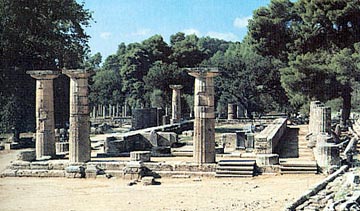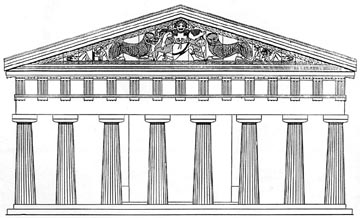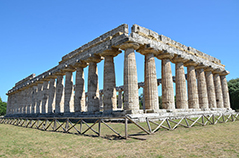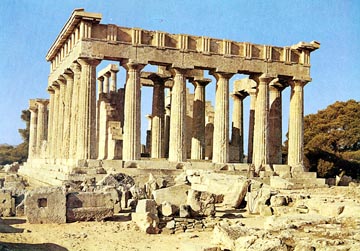Archaic Period
c. 600-480 BCE
DORIC TEMPLE ARCHITECTURE

Temple of Hera (Heraion)
Olympia
c. 590 BCE
The columns and entablature of the Temple of Hera at Olympia were originally of wood. The cella walls, up to the height of 3.5 feet, was of limestone, and above that mud brick. The roof was tiled and decorated with terracotta ornaments. The wooden columns were gradually replaced with stone as they wore out; one of the wooden columns is recorded by Pausanias as still standing in the 2nd century CE. The remaining capitals are of all styles with the echinus varying from flat to upright. In plan the temple has all the necessary components: cella, pronaos, opisthodomos, with 2 columns "in antis." However, the plan is still somewhat long in relation to width with 6 columns at the ends and 16 down the flanks.

Temple of Artemis
Corfu (Corcyra)
pediment
c. 580 BCE
The pediment survives in the Archaeological Museum, Corfu

Temple of Hera I
Paestum (Poseidonia)
c. 550 BCE
At Paestum near Naples in Italy. Constructed of limestone (travertine) and sandstone

Temple of Apollo
Corinth
c. 560 BCE
Constructed of limestone with a white stucco surface

Temple of Aphaia
Aegina
c. 500 BCE
In the Temple of Aphaia, the Doric canon is established in its main outlines. The temple is built of limestone which was originally stuccoed. It was dedicated to a local goddess and quite small. The columns represent a further elongation in proportions seen in the Late Archaic, showing a new thinness. The entablature is higher, giving the building a lightness not seen earlier. The temple has 6 columns at the ends and 12 on the flanks. The interior used superimposed rows of Doric columns on each side of cella, creating a two-storied colonnade.
|
© Christopher L. C. E. Witcombe
|

 SPRING 2016
SPRING 2016  SCHEDULE
SCHEDULE  REQUIREMENTS
REQUIREMENTS

 SPRING 2016
SPRING 2016  SCHEDULE
SCHEDULE  REQUIREMENTS
REQUIREMENTS